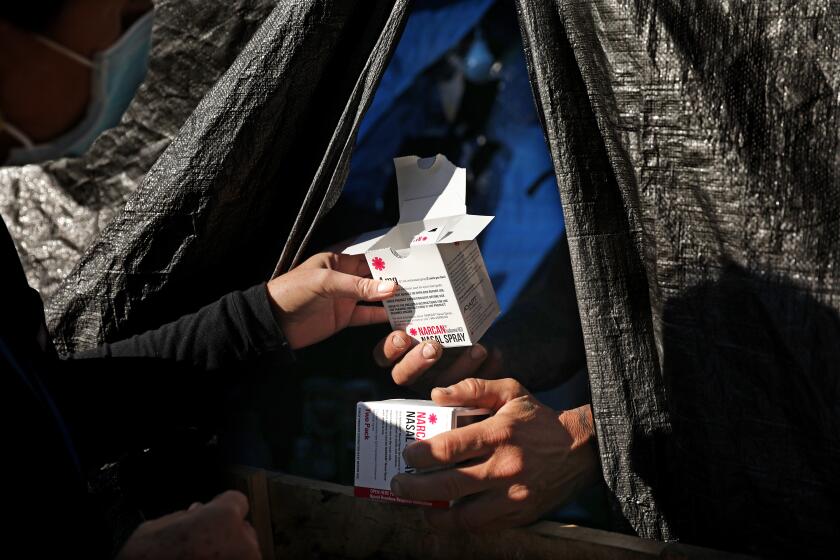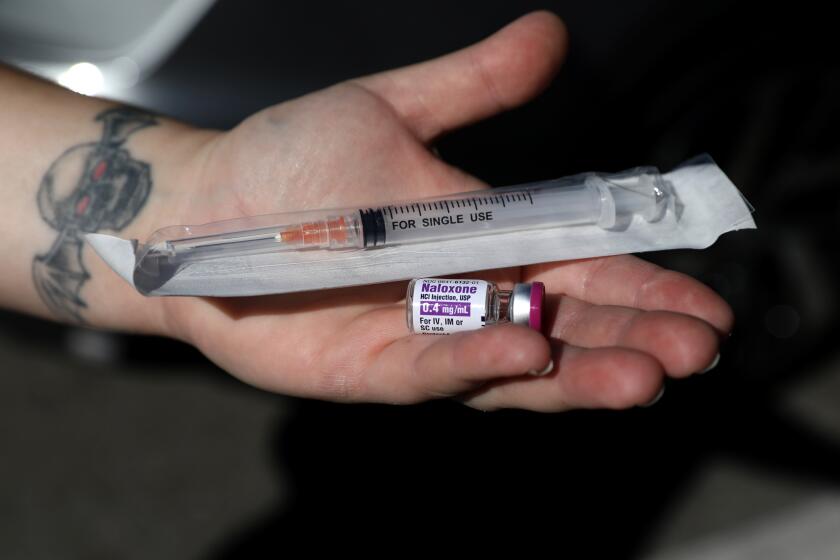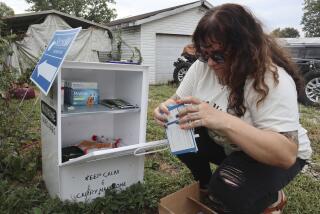In California, opioid settlement money helps fund lifesaving drugs and police projects
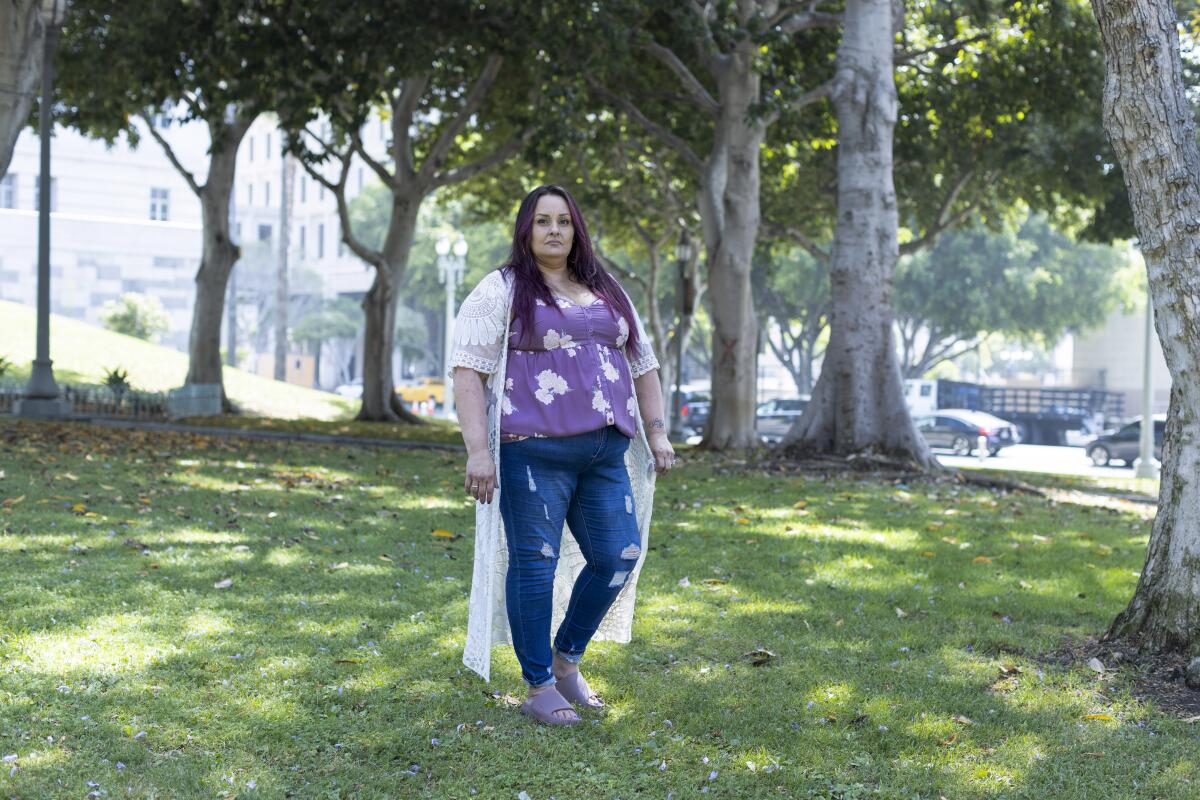
Sacramento â Sonja Verdugo lost her husband to an opioid overdose last year. She regularly delivers medical supplies to people using drugs who are living â and dying â on the streets of Los Angeles. And she advocates at Los Angeles City Hall for policies to address addiction and homelessness.
Yet Verdugo didnât know that hundreds of millions of dollars annually are flowing to California communities to combat the opioid crisis, a payout that began in 2022 and continues through 2038.
The money comes from pharmaceutical companies that made, distributed or sold prescription opioid painkillers and which agreed to pay about $50 billion nationwide to settle lawsuits over their role in the overdose epidemic. Even though a recent Supreme Court decision upended a settlement with OxyContin maker Purdue Pharma, many other companies have already begun paying out and will continue doing so for years.
California, the most populous state, is in line for more than $4 billion.
âYou can walk down the street and you see someone addicted on every corner â I mean itâs just everywhere,â Verdugo said. âAnd Iâve never even heard of the funds. And to me, thatâs crazy.â
Across the nation, much of this windfall has been shrouded in secrecy, with many jurisdictions offering little transparency on how theyâre spending the money, despite repeated queries from people in recovery and families who lost loved ones to addiction.
Meanwhile, thereâs plenty of jockeying over how the money should be used. Companies are lobbying for spending on products that range from medication bottles that lock to full-body scanners to screen people entering jails. Local officials are often advocating for the fields they represent, whether itâs treatment, prevention, or harm reduction. And some governments are using it to plug budget gaps.
A Los Angeles County initiative called Reaching the 95% aims to engage with more people than the fraction of Angelenos already getting addiction treatment.
In California, local governments must report how they spend settlement funds to the stateâs Department of Health Care Services, but thereâs no requirement that the reports be made public.
KFF Health News obtained copies of the documents via a public records request and is now making available for the first time 265 spending reports from local governments for fiscal year 2022-23, the most recent reports filed.
The reports provide a snapshot of the early spending priorities, and tensions.
Naloxone an early winner
As of June 2023, the bulk of opioid settlement funds controlled by California cities and counties â more than $200 million â had yet to be spent, the reports show. Itâs a theme echoed nationwide as officials take time to deliberate.
The city and county of Los Angeles accounted for nearly one-fifth of that unspent total, nearly $39 million, though officials say that since the report was filed theyâve begun allocating the money to recovery housing and programs to connect people who are homeless with residential addiction treatment.
Among local governments that did use the cash in the first fiscal year, the most popular object of spending was naloxone, a medication that reverses opioid overdoses and is often known by the brand name Narcan. The medication accounted for more than $2 million in spending across 19 projects.
One of those projects was in Union City, in the San Francisco Bay Area. The community of about 72,000 residents had five suspected fentanyl overdoses, two of them fatal, within 24 hours in September.
The opioid settlement money âwas invaluable,â Corina Hahn, the cityâs director of community and recreation services, said in her report. âHaving these resources available helped educate, train and distribute the Narcan kits to parents, youth and school staff.â
Death rate from overdoses stopped rising among unhoused people in the county in 2022 â the year L.A. County was stepping up life-saving efforts, a new report found.
Union City bought 500 kits, each containing two doses of naloxone. The kits cost about $13,500, with an additional $56,000 set aside for similar projects, including backpacks containing Narcan kits and training materials for high school students.
Union City also plans to expand its outreach to homeless people to fund drug education and recovery services, including addiction counseling.
Those are the sorts of lifesaving services that Verdugo, the Los Angeles advocate, said are desperately needed as deaths of people living on the streets pile up.
She lost her 46-year-old husband, Jesse Baumgartner, in June 2023 to an addiction that started after he was prescribed pain medications for a high school wrestling injury. He tried kicking his habit for six years using methadone, but each time prescribers lowered his dosage the cravings drove him back to illicit drugs.
âIt was just this horrible roller coaster of him not being able to get off of it,â Verdugo said.
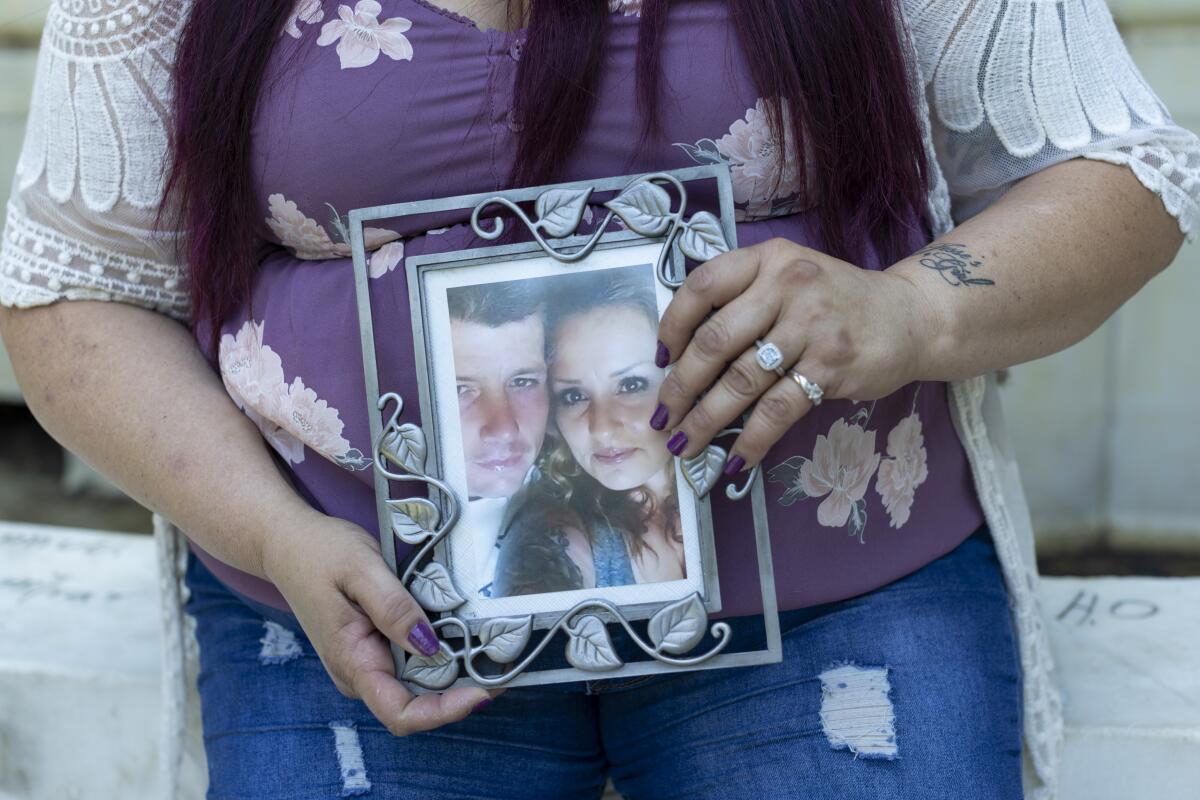
By then the couple had survived 4½ years of being homeless and had been in stable housing for about two years.
Fentanyl use, particularly among homeless people, âis just rampant,â she said. People sometimes are initially exposed to the cheap, highly addictive substance unknowingly when it is mixed with something else.
âOnce they start using it, itâs like they just canât backtrack,â said Verdugo, who works as a community organizer for Ground Game LA.
So she leaves boxes of naloxone at homeless encampments in the hope of saving lives.
âThey definitely use it, because itâs needed right then â they canât wait for an ambulance to come out,â she said.
Researchers at Stanford and elsewhere identified a compound that, when tested on mice, enhanced naloxone opioid-overdose-reversing effect and lessened withdrawal symptoms.
Cities backtrack on spending for law enforcement
By contrast, the cities of Irvine and Riverside listed plans to prioritize law enforcement by buying portable drug analyzers, though neither city did so in the first fiscal year, 2022-23. Their inclination mirrored patterns elsewhere in the country, with millions in settlement funds flowing to police departments and jails.
But such uses of the money have stirred controversy, and both cities backed away from the drug analyzer purchase after the Department of Health Care Services issued rules that opioid settlement funds may not be used for certain law enforcement efforts. The rules specifically excluded âequipment for the purpose of evidence gathering for prosecution, such as the TruNarc Handheld Narcotics Analyzer.â
In Hawthorne the police department had already spent about $25,000 of settlement funds on an initial installment to buy 80 BolaWraps, devices that shoot Kevlar tethers to wrap around a personâs limbs or torso.
After the state said BolaWraps were not an allowable expense, the city said it would find other funding sources to pay the remaining installments.
Santa Rosa, in Californiaâs wine country, spent nearly $30,000 on police officer wellness and support.
The funds allowed the police department to boost its contracted wellness coordinator from a part-time to a full-time position, and to buy a mobile machine to measure electrical activity in the brain, said Sgt. Patricia Seffens, a spokesperson.
The goal is to use the technology on police officers to help âassess the traumatic impact of responding to the increasing overdose calls,â Seffens said in an email.
In Dublin, east of San Francisco, officials are using part of their $62,000 settlement for a DARE program.
DARE, which stands for Drug Abuse Resistance Education, is a series of classes taught by police officers in schools to encourage students to avoid drugs. It was initially developed during the âJust Say Noâ campaign in the 1980s.
Studies have found inconsistent results from the program and no long-term effects on drug use, leading many researchers to dismiss it as âineffective.â
But on its website, DARE cites studies since the program was updated in 2009, which found âa positive effectâ on fifth- graders and âstatistically significant reductionsâ in drinking and smoking about four months after completing the program.
âThe DARE program when it first came out looks a lot, lot different than what it looks like right now,â said Nate Schmidt, the Dublin police chief.
Schmidt said that additional settlement money will be used to distribute naloxone to residents and to stock it at schools and city facilities.
Other local governments in California spent modest sums on a wide range of addiction-related measures. Ukiah, in Mendocino County, north of San Francisco, spent $11,000 for a new heating and air conditioning system for a local drug treatment center. Orange and San Mateo counties spent settlement funds in part on medication-assisted treatment for people incarcerated in their jails. The city of Oceanside spent $16,000 to showcase drug prevention art and videos made by middle school students in local movie theaters, public spaces, and on buses and taxis.
The Department of Health Care Services said it plans to release a statewide report on how the funds were spent, as well as the individual city and county reports, by yearâs end.
The state and L.A. County have worked hard to make Naloxone more widely available. One of the hurdles, though, has been the price of the inhalable version, Narcan.
More to Read
About this article

